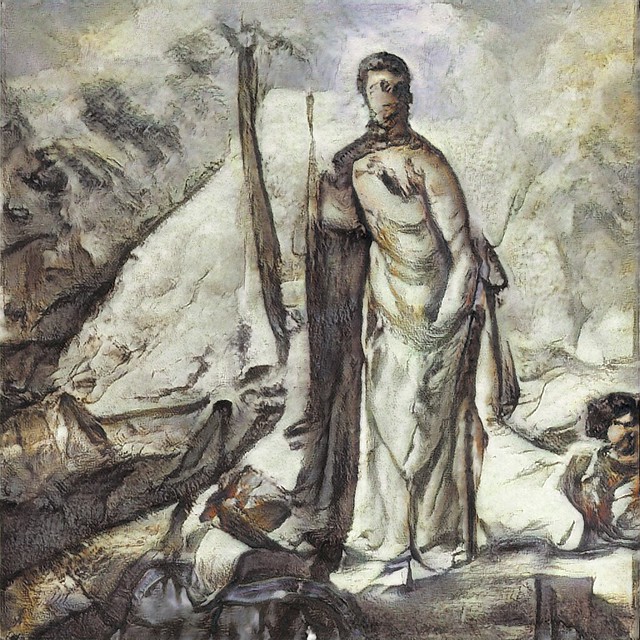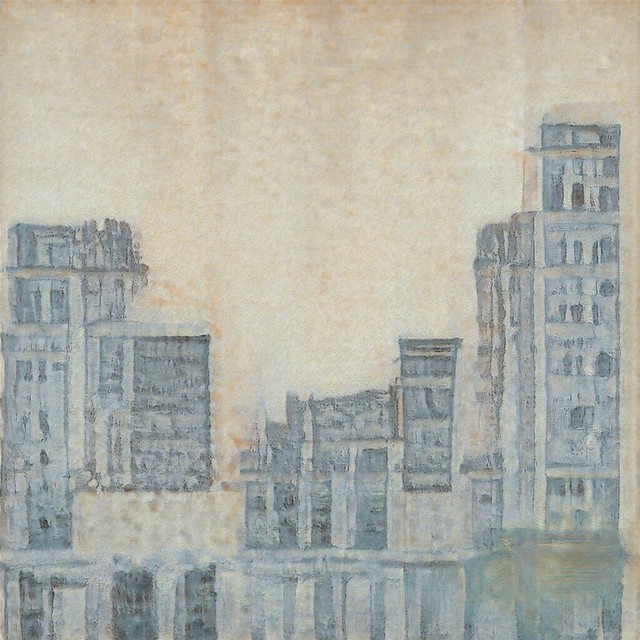“Seneca”, by Carlos Tejeda Ocampo (2019)
Deep Interactive Evolution (DeepIE) is a novel approach for artifact generation combining generative adversarial networks (GANs) with interactive evolutionary computation (IEC). Generative models such as GANs learn representations of the training data in a vector space of latent variables. DeepIE demonstrated the feasibility of using interactive evolutionary algorithms to evolve “better” latent vectors for generating images. For each generation, the user selects the most desirable images from a population. Then, the selected image’s latent vectors are used as parents to generate a new population of latent vectors by uniform crossover and mutation. The process is repeated until the user is satisfied with the results. The core idea behind DeepIE is that the latent space of a trained model can be explored by the user through interactive evolution.
We used DeepIE to make an art series entitled “The Transfiguration of the Latent Space”. The title is an allusion to Arthur C. Danto essay on the philosophy of art:”The Transfiguration of the Commonplace”. While controversial, Danto outlines a tentative definition of art: for a work to be consider an artwork it has (i) to beabout something, to have meaning and (ii) to embody its meaning. This thesis relies heavily on Duchamp and his concept of “ready-made”. We implemented a version of DeepIE with minimal interface: Starting from a randomly generated population of 20 individuals, the user selects the images theyconsider desirable to generate the next population The process can continue for an undetermined number of generations until the user decides to stop. Then the user is free to select, from all the generated images, one of their liking. Once they have made their final choice, they are asked to name the selected image. This process was repeated with 10 volunteers with no prior art background.
10 artworks were generated by the volunteers with the previously explained process. We argue that the volunteers engaged in a creative process when selecting the images for the evolutionary algorithm. Every time they selected an image they endowed it with meaning, their final choice being the most significant one. When asked to name their definitive image, they had to make a conscious decision on how they wanted that meaning to be conveyed. Is by the act of naming that the meaning is solidified, it becomes”embodied in the artwork” using Danto’s terminology. We argue that this process is analogous to the ready made propossed by Duchamp. The volunteers did not design the network nor code the implementation. They did not train the model nor curated the dataset. However, they searched the latent space and made the relevant decisions. This is what, at least for Duchamp and Danto, makes them artists. We argue that “ready-made” provides us with a conceptual framework to understand art generation not only on DeepIE but also on any other generative technique that requires human curation. The model could have been any generative model and the search algorithm could have been entirely random for that matter. The meaning lies ultimately in the choices.
Acknowledgments:We would like to thank Philip Bontrager, Wending Lin, Julian Togelius and Sebastian Risi for their work on DeepIE and for sharing their code. DeepIE is an interesting novel approach to explore the latent space of generative models. The volunteers had an overall positive experience with the system, they found it engaging and fun. More research is needed in order to explore its full potential for creative work and artistic expression. We also thank Gene Kogan for allowing us to use his StyleGAN model for our project. Special thanks to everyone who volunteered for this project.
The rest of the series can be viewed here: https://cto300.tumblr.com/transfiguration
Adtitional Images:
“La vida es absurda”, by Gera Suarez (2019)
“Life on Mars”, by Daniela Tejeda (2019)
“Snowfall”, by Michael Zenkl (2019)



